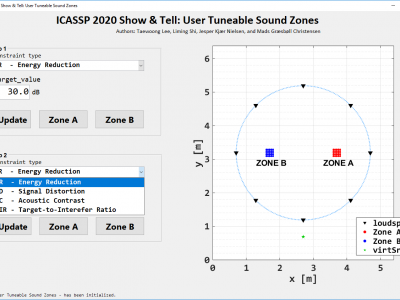Documents
Demo
User Tuneable Sound Zones

- Citation Author(s):
- Submitted by:
- Taewoong Lee
- Last updated:
- 14 May 2020 - 4:38am
- Document Type:
- Demo
- Document Year:
- 2020
- Event:
- Presenters:
- Taewoong Lee
- Paper Code:
- S&T-P8.3
- Categories:
- Log in to post comments
Creating sound zones has been an active area of research since it was first introduced. Generally, this can be done either by maximizing an acoustic contrast that represents the acoustic potential energy ratio between the bright and dark zones or by minimizing a reproduction error between the desired and reproduced sound fields. However, the former suffers from severe distortion in the reproduced sound field, whereas the latter suffers from poor acoustic contrast. Recently, a flexible and general framework for sound zone control that is referred to as the variable span trade-off (VAST) filter has been proposed. The VAST framework allows the user to control the trade-off between the acoustic contrast and the signal distortion by adjusting user parameters. Unfortunately, the parameters are not physically meaningful and the user has to tune them for different source material and acoustic environment. In this demo, we demonstrate a precise and accurate control across the reproduced sound fields obtained by reformulating the problem using physically meaningful constraints, such as the signal distortion and the acoustic contrast. On top of this, we also demonstrate perceptually optimized sound zones by taking the characteristics of the input signals and of human auditory system into account (see https://youtu.be/msLp0Xeo0rk for more on the perceptually optimized sound zones). The demo consists in a MATLAB program (see https://youtu.be/SUyq8IjBe-Q?t=1568) which allows the user to select and specify one constraint from a list of physically meaningful constraints and listen to the resulting reproduced sound fields not only in the zones but at an arbitrary point on a plane in a room. To this end, one will experience and compare the results from different positions and constraints.

